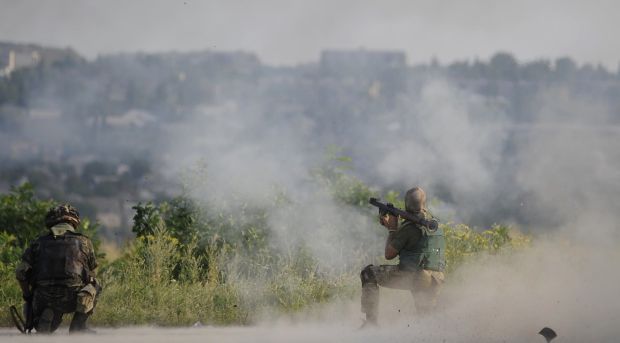
Maryinka as an indicator of another ‘hot summer’
The failed militant attack on Maryinka still leaves hope for a quiet summer in the Donbas. UNIAN asked experts why Russia tried to increase the degree of confrontation.
In the early hours of June 3, pro-Russian militants tried to break through the Ukrainian defenses around Maryinka with the use of Grad multiple launch rocket systems and tanks – weapons supposed to be withdrawn from the contact line, according to the Minsk agreements. Later, the General Staff of the Armed Forces of Ukraine announced that the attack on the forces of the anti-terrorist operation (ATO) under Maryinka was carried out by nearly 1,000 militants, supported by ten tanks. The Information Resistance group reported that both the front line and tactical rear of Ukrainian troops were massively shelled by MLRS BM-21 Grad.
Nevertheless, the Ukrainian forces managed to stop the attack of the Russian-terrorist troops. After a few tactical maneuvers and attempts to get through the flanks, the militants were rebuffed in a firefight, and were forced to retreat. Moreover, having come under artillery fire by ATO forces, Russian-terrorist troops suffered heavy losses. Ukraine’s military speaker Andriy Lysenko reported that the illegal armed groups lost up to ten armored vehicles, 80 militants were killed, and over 100 were wounded during the battle for Maryinka. At the same time, presidential adviser Yuri Biryukov said that four Ukrainian military servicemen were killed and another 39 were injured in the fighting.
Speculating with the Minsk agreements
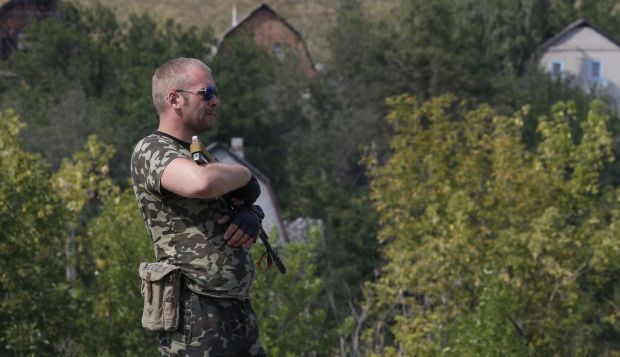
Curiously, the leaders of the DPR militant organization, who earlier posted on the social networks that they had taken over Maryinka, then started complaining about violations of the Minsk agreements by the Ukrainian forces, saying that the use of artillery was prohibited. At the same time, the militants refused to talk to the OSCE monitoring mission, which had previously spotted tanks, infantry fighting vehicles and artillery pieces moving in the direction of Maryinka. In particular, the OSCE representatives noted that “the DPR leadership” refused to comment on the movement of its heavy military equipment around Maryinka.
As for artillery strikes on militants by the Ukrainian troops who held their defense against the terrorists’ attack, the ATO headquarters, having notified its international partners, decided to use this type of weapon, previously withdrawn from the demarcation line in accordance with the Minsk agreements, in order to appropriately respond to the enemy’s offense and to protect the lives of soldiers and civilians.
The EU representative on foreign and security policy Maja Kosjancic has already stated at a briefing in Brussels that this fighting was the most serious violation of the Minsk agreements. “We are concerned about the fighting in Maryinka near Donetsk, which is the most serious violation of the ceasefire under the Minsk Agreement since February,” she said.
In turn, Russia immediately rushed to blame Ukraine for the intensification of military operations in the Donbas. The head of the State Duma Committee on Foreign Affairs Alexei Pushkov tied the escalation of the conflict with the approach of the date when the European Union may decide to extend sanctions against Russia. And, of course, he blamed Ukraine, while “forgetting” to mention that the intense fighting in Maryinka had been started by Russia-backed militant groups.
At the same time, U.S. State Department spokesman Marie Harf said that the fighting near Maryinka began with the DPR offensive. In her opinion, Russia is directly responsible for preventing such incidents. In this regard, Harf did not rule out the further expanding of sanctions.
Russia raises the stakes
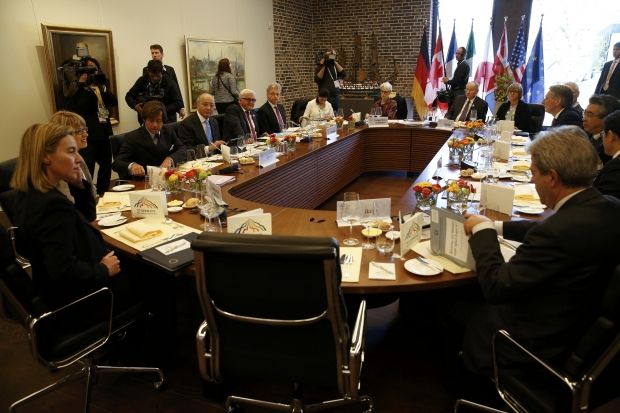
Indeed, the burden of Western sanctions is one of the things which is connected with intensification of fighting in the Donbas. Political strategist and director of Berta Communications Taras Berezovets believes that ahead of the G7 Summit, Vladimir Putin was cynically raising the stakes, trying to achieve certain concessions from the West, and wanted the sanctions to be lifted, paradoxically, despite the clear violation of the Minsk Agreement. At the same time he was also trying to reduce the damage to Russia, in particular, due to the fact that FIFA can take away the 2018 World Cup from Russia (there is such probability in case of the resignation of Sepp Blatter from the post of FIFA president). This opinion was echoed by Valentyn Badrak, director of the Research Center for Army, Conversion and Disarmament, “Putin is creating an additional trump card, as if to say: ‘if the sanctions are not lifted, the war will continue ... and that the West won’t be able to dictate anything to him.”
But as we see today, the West kept a firm stance on the sanctions issue and didn’t give in to such blackmail during the G7 Summit.
According to Badrak, the Russian authorities are aware of the fact that the Russian-terrorist groups in the Donbas will not be able to create the corridor to Crimea, and in the case of the deployment of the regular Russian army, there will be many more problems. That is why, according to Badrak, Russia is using its officers and soldiers “secretly, as leaders of terrorist units.” “The modernized strategy of warfare in the Donbas is also aimed at undermining the Ukrainian government from the inside. With the first anniversary of the presidency of Petro Poroshenko, this is a very opportune moment to show that the president failed to do anything good for the country for the whole year, although he had promised to complete anti-terrorist operation in a matter of hours,” he said.
Thus, the Russian-terrorist forces have two key objectives before them. On the one hand, the military objective is to provoke a counterattack. On the other hand, a non-military objective is to discredit the Ukrainian authorities in the eyes of Ukrainian soldiers and their families, causing discontent and distrust in the authorities.
The diplomacy of force
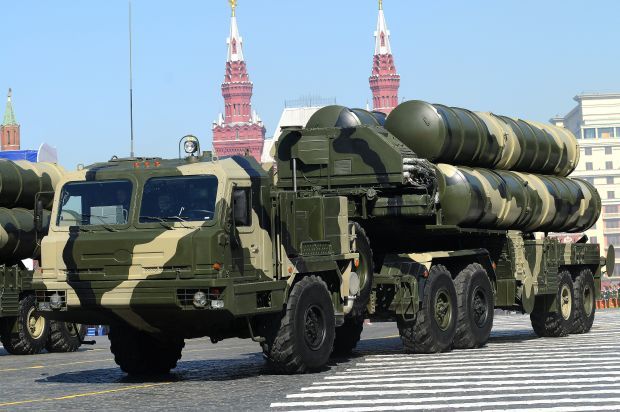
In turn, Volodymyr Fesenko, the chairman of the Penta Center for Applied Political Studies, says he believes that the deterioration of the situation in the east of Ukraine is to a greater extent due to the fact that the Kremlin earlier failed to impose its scenario on the negotiations in Minsk. “The Russian Ambassador made a demarche, leaving the meeting of the Tripartite Liaison Group. In Minsk, Russia apparently sought to achieve a certain accelerated result, wanted to put the squeeze on Ukraine in the negotiation process to make it agree to the Russian scenario of conflict settlement in the Donbas. But Ukraine has not been making any concessions, especially in the framework of the Russian scenario,” said the analyst.
Actually, in order to speed up the negotiation process, Russia has decided to use their traditional weapons - forcing peace through war. “That is, by the intensification of the war, it tried to have influence on us and on the Europeans, blackmailing with the escalation of the conflict, trying to force an agreement according to the Russian scenario... This is not the only a military objective, it is the diplomacy of force,” he said.
However, according to Fesenko, the attempt to frighten the Western leaders and also Ukraine with the threat of war was not successful. And that, in his opinion, allows for some time for a certain stabilization of the situation in the east of Ukraine. “The Maryinka offensive was a kind of a test: if we can seize more territory near Donetsk, we can also do this in other key sectors of the frontline... A tactical task for the separatists and Russia is to squeeze the Ukrainian troops away from Donetsk and Luhansk,” he added.
In turn, MP from the “People's Front”, the coordinator of the “Information resistance” online media outlet Dmytro Tymchuk believes that the leadership of the Russian terrorist forces in the Donbas, under the guise of “Minsk-2” agreements, tried to create a prototype of a regular army with a common command and control system, a single logistics system, a powerful base for repair and replacement of weapons and equipment. So, the attack on Maryinka was a “reconnaissance in force.” “Had the terrorists thrown in all their forces, adding those battalion tactical groups from the Russian Armed Forces, which had massed up near borders - the situation would have been much more difficult, he said. Let's hope that these events sobered up the always drunken supporters of Novorossiya, But we should keep our guard.”
Kremlin changes its tactics
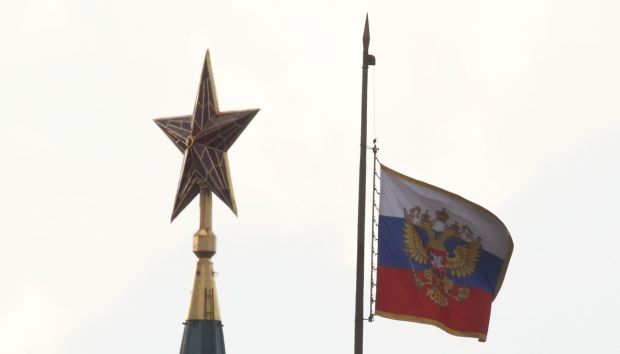
According to Valentin Badrak, Ukrainian forces showed their willingness and ability to repel an aggressor during the Maryinka defensive. However, a preventive mechanism to counter such offensives should be formed. It is not an offensive that we should respond to, but the enemy’s very plans. “Even with no strong army intelligence, the movement of heavy equipment, tanks, light armored vehicles and personnel was spotted ahead of the fighting in Maryinka,” he said.
In this regard, according to a military expert, a clear step by step scheme of Ukraine's actions for such cases should be formed in future. For example, upon receiving information about the movement of enemy equipment, Ukraine must immediately inform the Western partners about the readiness of the Ukrainian army to repel such actions by the Russian-backed militants with force. If there is enemy military equipment in the line of sight, it must be struck without warning. “Thus, we get a transition to an active defense,” he said.
However, the Russian media have already been actively spinning the information on full readiness of Ukrainian forces for an offensive. According to the Da Vinci analytical group, this indicates that Moscow is radically changing its policy and strategy of trying to move from a military to a political and economic solution. “According to our estimates, the active and purposeful dissemination of this information is due to lack of manpower and resources to monitor the personnel of the illegal armed units of so-called DPR and LPR,” reads the group’s report.
In this context, the threat of a possible offensive by ATO forces is the only factor that can keep control over the militant units, as well to keep up the morale of the Novorossiya supporters.
Authors: Kostyantyn Honcharov, Tatiana Urbanskaya

